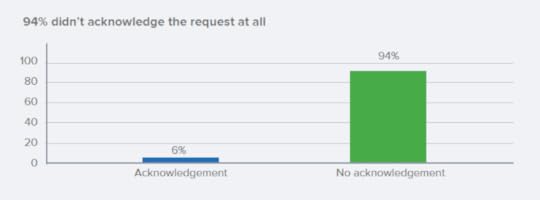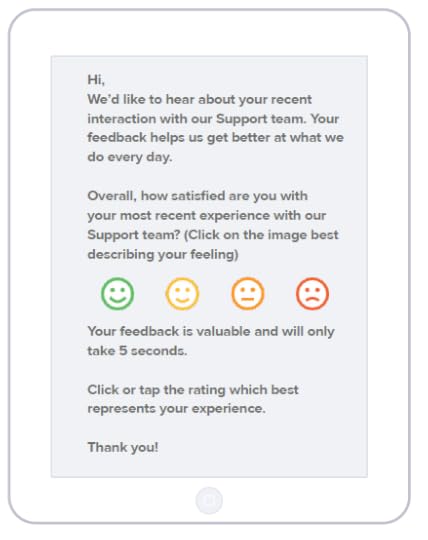Shep Hyken's Blog, page 172
March 15, 2017
Customers Buying Habits Are Changing. Are You Keeping Up?
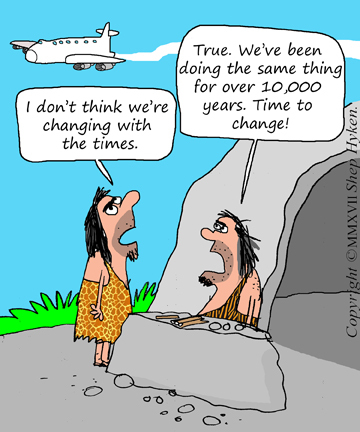 Every day I get an email from RetailWire.com, a daily publication that is read by thousands of people in the retail industry. It’s the number one forum for discussions about hundreds of important issues in the industry. Now, before we go further, even though RetailWire.com focuses on the retail industry, what I’m about to share is relevant to every business in every industry.
Every day I get an email from RetailWire.com, a daily publication that is read by thousands of people in the retail industry. It’s the number one forum for discussions about hundreds of important issues in the industry. Now, before we go further, even though RetailWire.com focuses on the retail industry, what I’m about to share is relevant to every business in every industry.
A recent article in RetailWire posed a question about virtual reality and if it will make brick-and-mortar stores less relevant. By the way, if you haven’t experienced virtual reality, you must. It’s incredible. You put on what looks like goggles and you see the most amazing three dimensional images and videos. Okay, back to answering the question. My response was that virtual reality and augmented reality are just enhanced ways of viewing and experiencing products online. Yes, it will change the way people shop online, but it’s still “virtual.” It’s not real! You can’t touch the material to determine the quality of the suit or dress you’re looking at through a virtual reality headset. You can’t try it on either. So, how could this technology make physical stores less relevant?
The discussion of physical stores becoming irrelevant has been a topic of conversation for years. The first online purchase was made in 1994. According to a video produced by Shopify, an online shopping software program, the first online transaction was on August 11, 1994 through Dan Kohn’s online startup company when a friend bought a Sting CD over the internet. People said this kind of business would never work. People would never buy online. Well, never say never. Shortly after that Amazon came into the picture. And, here we are today.
Adobe’s research claimed last year’s Black Friday’s online sales were over $3 billion. And Cyber Monday’s sales, just three days later were also over $3 billion. Forrester predicts that by the year 2020, just three years from now, online sales will exceed $523 billion!
So, should retailers be scared? Maybe… because some retailers aren’t willing to change. And there are companies in virtually any industry that aren’t willing to change either. So, here is the lesson:
Business – in all industries – is changing. The old saying is true: The only thing that is consistent is change. So, get used to it.
Will online stores kill physical stores?
Did ATM’s eliminate bank tellers?
Did “Video Kill the Radio Star” when MTV went live back in 1981?
The answers are no, no and no!
Maybe the consumer is migrating to do more shopping online. It may make a physical store a little less “relevant” – but it doesn’t make the retailer less relevant! A retailer, as anyone or any company in business, must adjust and change. What makes a retailer less relevant won’t be because sales are moving from in-store to online. It will be because the retailer doesn’t adapt to the way their customers want to buy. And, it’s the same for any business. Your customers buying habits are changing. Adapt or watch your business die a slow and painful death. You must be willing to change as your customer’s change.
Shep Hyken is a customer service expert, keynote speaker and New York Times bestselling business author. For information contact or www.hyken.com. For information on The Customer Focus™ customer service training programs go to www.thecustomerfocus.com. Follow on Twitter: @Hyken
(Copyright © MMXVII, Shep Hyken)
Save
Save
Save
The post Customers Buying Habits Are Changing. Are You Keeping Up? appeared first on Shep Hyken.
March 14, 2017
Amazing Business Radio: Keith Pearce
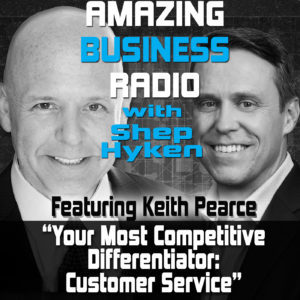
Keith Pearce From Salesforce Talks About Your Most Competitive Differentiator: Customer Service
What are the major trends that are evolving in customer service, what do you need to do to keep up, and why?
Shep Hyken interviews Keith Pearce, VP Product Marketing, Salesforce Service Cloud. Shep and Keith will discuss the motivation behind businesses doubling down on customer service as customer expectations evolve in the always-on, on-demand environment.
First Up:
Shep Hyken’s opening comments focus on Salesforce’s State of Service Research Report, which shows that connected customers are going to reshape the service industry. Customer service and the customer experience are going to completely dominate the competitive nature of business. According to the report, 85% of business executives believe that customer experience is a key competitive differentiator. Further, empowered customers expect their customer service to be personalized. Finally, 69% of consumers and 82% of business buyers say that personalized customer care has a major or moderate impact on their loyalty toward companies.
Featured Interview:
Shep begins his interview with Keith Pearce asserting that as products and services become more commoditized, customer service is the only sustainable differentiator that most companies have.
Pearce states that we are all mobile-driven first. Increasingly, we see more and more consumers using mobile messaging. Not just SMS, but mobile messaging apps like Facebook Messenger. Companies need to be present on those apps. We are moving to conversational service, to provide service where the customers are.
Top Takeaways:
Artificial intelligence (AI) rises to the top. Service leaders are looking to leverage AI to provide a more intelligent, personalized and conversational form of service.
It’s not just about the customer service department If a company is going to be a customer service and customer experience leader, it needs to break down the departments it established to form the enterprise. It needs to communicate and collaborate across the company to provide a great customer experience.
Companies will realize that service is not just something they have to do, instead it is a competitive differentiator, and it’s strategic. This is good news for anyone in the service industry, because it is about to go through a major disruption.
About:
Keith Pearce is responsible for marketing strategy, vision and execution in his role as Vice President of Marketing for Salesforce Service Cloud. He brings more than 20 years of experience in the customer service, call center management and cloud industries.
Shep Hyken is a customer service and experience expert, best-selling author and your host of Amazing Business Radio.
“A consumer is not trying to do business with a department. They don’t think that way. They just want to get help from your company, in the fastest form possible.” -Keith Pearce
This episode of Amazing Business Radio with Shep Hyken answers the following questions… and more:
What are the main trends in customer service for 2017? How does AI fit into the customer experience?
How can customer service differentiate you from your competition?
Is collaborative customer service the future of the industry? Which departments should support agents align with?
How do companies empower customer service agents, in our instant gratification and social media driven world, to handle customer complaints?
Save
Save
The post Amazing Business Radio: Keith Pearce appeared first on Shep Hyken.
March 13, 2017
5 Top Customer Service Articles For the Week of March 13, 2017
Each week I read a number of customer service articles from various online resources. Here are my top five picks from last week. I have added my comment about each article and would like to hear what you think too.
47 Social Media Statistics to Bookmark for 2017 by Alex York
(Sprout Social) Right when you think you’re getting a grasp on your demographics, buyer habits and trends on social media, something new changes and turns your data into old news. That’s why it’s absolutely critical for any marketer to stay up to date on the newest social media statistics.
My Comment: It has been said that customer service is the new marketing. If that is the case, then social media customer service (also known as “social care”) falls into that category. Here’s a statistic you won’t believe. 89% of social media messages to brands go ignored. Holy Moly! If you find that stat interesting you’ll love what Sprout Social has put together in a special report titled “47 Social Media Statistics to Bookmark in 2017.”
A Recipe for Consistent Customer Service: 5 Key Ingredients by Jeremy Watkin
(CustomerThink) It’s great when agent and customer click and we as the audience get to replay them over and over again, and just feel all warm and fuzzy the entire time. But the reality many of us customer service leaders know all too well is that this type of service can be inconsistent at best. Here are a few common scenarios I’ve been privy to over the course of my career.
My Comment: Jeremy Watkin lives and breathes customer service. He manages a team of customer support professionals and knows what the best customer service looks like – and how to deliver it. In this informative article he shares five of the ways his team delivers a consistent customer experience. This is information that can help any business in any industry.
How To Provide Witty And Effective Customer Support On Social Media by Jimmy Rohampton
(Forbes) Since millennials love to get customer support via social media, they’re also more likely to want to offer it to their customers when they’re the company founders. If you’re a millennial founder, here are some tips to help you and your team offer witty and effective customer support on social media.
My Comment: Get ready to smile. This article is focused on social media customer service – responding to customers’ posts on social media channels like Twitter and Facebook. And, one effective way to respond, when appropriate, is to use humor. The example in this article will make you laugh. A great example of how you can have fun with your customers and “humanize” your customer service.
Retail Can Learn Valuable Lessons from B-to-B by Richard Shapiro
(TCFCR) Retailers would be wise to take direction from successful B-to-B enterprises and learn how to handle new customers, how to better serve the consumer, and mirror the way new business accounts are valued and coddled.
My Comment: So many articles on customer service focus on the retail industry (B-2-C). While there is much to learn about how to deliver service to consumers, it is refreshing to read this article about what business to business (B-2-B) companies can teach retail. The bottom line is that any business can learn about customer service from any type of business. Richard Shapiro covers three “sales phases” that can positively impact your customer’s experience.
3 Best Practices to Retain Customers and Stop Churn by Sarah Frazier
(CustomerGuage) In our most recent eBook and How to Become a Customer Retention Champion infographic, we walked through best practices for retaining your customers and stopping churn. We’ll expand upon these lessons learned and highlight the main takeaways.
My Comment: If customer loyalty is important to you and your business (and I know it is), then take a few minutes to not just read, but study this article. The simple, yet powerful, “best practices” behind customer retention are followed with an infographic that makes customer loyalty and retention easy to understand.
Shep Hyken is a customer service expert, professional speaker and New York Times bestselling business author. For information contact or www.hyken.com . For information on The Customer Focus™ customer service training programs go to www.thecustomerfocus.com . Follow on Twitter: @Hyken
Save
The post 5 Top Customer Service Articles For the Week of March 13, 2017 appeared first on Shep Hyken.
March 10, 2017
Guest Blog: 3 Simple Ways (Backed by Research) to Improve Customer Service Quality
This week on our Friends on Friday guest blog post my colleague, Steven Macdonald, shares the results of a study examining how companies around the world respond to customer service requests. I find the results quite alarming! – Shep Hyken
Good customer service – especially in response to customer service requests – is one of the most valuable investments any organization can make.
However, there’s a discrepancy between service provided and service received, as 80% of companies believe they deliver a superior service, while only 8% of customers agree with them.
That’s why SuperOffice recently conducted the Customer Service Benchmark report– a comprehensive study, which examines how 500 companies of all sizes around the world respond to customer service requests.
To keep the study simple, one email was sent to each company containing two simple questions:
Do you have a phone number I can call you on?
Where can I find pricing information on your website?
Each company then received a score out of 100 for their response.
The results from the study revealed an alarming picture of how companies ignore some of the most fundamental best practices in customer service. Don’t worry – we’ve gone through all the data for you and selected the three most important areas for improvement, along with simple techniques to resolve the issue.
Inform customers that you have received their request
When a customer sends an email, they never quite know what happens after they click send. That uncertainty is understandable and means the customer is likely to continue looking elsewhere or slowly lose interest in making a purchase. Alternatively, they might try to contact the company through other channels, from social media to phone lines, and waste time on both sides.
That’s why an immediate acknowledgement in the form of an auto-response is essential – to let the customer know you have received their request and they know that you are working on a solution.
Remarkably, 94% of companies do not acknowledge their customer service requests have been received, despite the enormous benefits and considerable ease at which the solution can be implemented.
Auto-replies are simple to set up in Outlook, although most customer service software comes with added advantages like the ability to tag all emails with a unique code for tracking requests. You could even provide an estimated response time that is more accurately based on the current workload of the customer service team.
Respond to customers as quickly as possible
The faster companies respond to customer service requests, the better.
Research shows that customers are more likely to make a purchase the closer in time to when they made the initial inquiry. You are 100x more likely to successfully contact a lead if you respond within 5 minutes and 21x more likely to qualify that lead.
That’s why a quick response time is one of the most important metrics for measuring good customer service. Yet, the average response time in 2016 was 15 hours and 17 minutes, which is hardly the superior service that most companies believe they deliver.
To respond quickly, make sure the correct department receives the customer request. For example, you can create a separate email address for customer service, invoices and technical support so that when a customer contacts each department, a specialist can reply in a timely manner.
Follow-up with customers to see if they’re happy with the level service
A customer service request indicates to a company that someone is interested in making a purchase. It should therefore be smart business sense to follow up with that person to find out if they went through with their purchase or if they need more assistance.
Unfortunately, only 3 out of 500 companies actually practiced this. That’s not even 1%.
It gets worse. Only one company out of 500 followed up to check rate the level of service.
Following up with a customer is a great opportunity to find out if customers are happy with the level of service you provide and helps you close any requests that are still open. For inspiration on what to include in the follow up, use the email support template below.
Conclusion
In the digital age, no organization can afford to ignore customer service requests from potential customers. Worst of all; there is an enormous gap between the level of customer service that most companies think they are delivering and the actual level of customer service that their customers receive.
Investing in customer service is invaluable for any organization and by implementing the simple tips above; you can easily improve the quality of service you provide to help you stand out from the competition and create a happy and loyal customer following.
Steven Macdonald in a digital marketer based in Tallinn, Estonia and writes about all things customer service related on the SuperOffice blog.
For more articles from Shep Hyken and his guest contributors go to customerserviceblog.com.
Read Shep’s latest Forbes Article: Moving From Omni-Channel To A Channel-Less Customer Experience
Save
Save
Save
Save
The post Guest Blog: 3 Simple Ways (Backed by Research) to Improve Customer Service Quality appeared first on Shep Hyken.
March 8, 2017
Who Owns Customer Service?
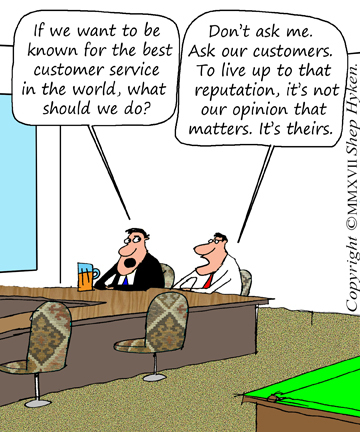 Customer service is what I’m all about. It is my life’s mission to help companies create a customer service experience that customers think is amazing. So, I thought it would be nice to own the domain name CustomerService.com. But, surely some company that is totally focused on their customers would already own it. So, I typed the URL into the Internet browser and found out… it was for sale. Nobody was using this domain. Really?
Customer service is what I’m all about. It is my life’s mission to help companies create a customer service experience that customers think is amazing. So, I thought it would be nice to own the domain name CustomerService.com. But, surely some company that is totally focused on their customers would already own it. So, I typed the URL into the Internet browser and found out… it was for sale. Nobody was using this domain. Really?
I thought to myself that it would be cool for my brand to own this domain. How much could this be worth? Well, it was expensive, at least by my standards… unless I wanted to have an asset that would brand me to customer service forever. Of course, I would! However, budget is an issue, because domain names like these sell for big dollars.
That made me start thinking of the brands that would love to have their name synonymous with CustomerService.com. The first ones that came to mind were the obvious rock stars in the business world. American Express, Amazon, Ace Hardware, Nordstrom, Ritz-Carlton, Lexus, Zappos… I think you get the idea. These are the brands known for amazing service.
Or how about a brand like Comcast Cable? It was just a few years ago when a phone call from a customer to their support center was handled poorly and went viral across the Internet. Since that time Comcast has been working hard to turn around their reputation. So, does owning CustomerSerivce.com make sense for them? If so, they better hurry before one of their competitors, like AT&T or Sprint beats them to it.
Whoever does decide to buy the name should be prepared to pay a good price for it. I’m predicting the owners will sell the domain name for more than seven figures, but for the right brand it will be well worth it. For example, who better to own Toys.com than Toys ‘R’ Us. In 2009 they paid $5.1 million. If you’re in the mortgage business, it seems like Loans.com would be a natural. In 2000 Bank of America bought the domain name for $3 million. Imagine owning the URL that can help define who you are.
So, which brand should own CustomerService.com? Why not you?
Hypothetically (or maybe not), what if you did own the URL? That would mean you would have to live up to “owning” customer service. Do you believe you are worthy of owning it? More important, do you believe that your customers would agree that you are worthy of owning it? If you did own it, would you do anything different than you’re doing now to live up to the expectation of a brand that owned CustomerService.com?
These questions are good ones. So, pretend you own the URL. Do a little homework. Take some time to answer the questions, as if you did own the name. Your answers may give you a few ideas to deliver an even better customer service experience. The point is, whether you own CustomerService.com or not, I want you to play as if you do.
Shep Hyken is a customer service expert, keynote speaker and New York Times bestselling business author. For information contact or www.hyken.com. For information on The Customer Focus™ customer service training programs go to www.thecustomerfocus.com. Follow on Twitter: @Hyken
(Copyright © MMXVII, Shep Hyken)
Save
Save
Save
The post Who Owns Customer Service? appeared first on Shep Hyken.
March 7, 2017
Amazing Business Radio: Martha Brooke
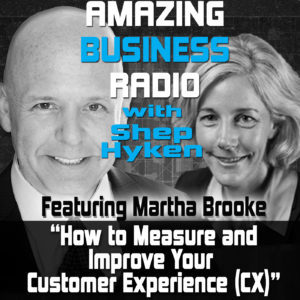 Martha Brooke on How to Measure and Improve Your Customer Experience (CX)
Martha Brooke on How to Measure and Improve Your Customer Experience (CX) What is the best way to improve your customer experience?
Shep Hyken interviews the Chief Customer Experience Analyst and Founder of Interaction Metrics, Martha Brooke, who says she thinks about customer experiences differently. “Experiences can be measured,” Martha says, “and measuring is how you improve—but only if your measurement is sufficiently nuanced.”
First Up:
Shep Hyken’s opening comments focus on a CX Solutions (formerly TARP Worldwide) study which showed that only 4% of customers that were “wronged” by a business will actually complain to that company. The important point is not that other 96% of the customers don’t complain; they do, but they instead send that unhappy message on to family members, friends, and colleagues at work. But perhaps what is now even more damaging to a business, they use social media channels to broadcast their dissatisfaction… to the world.
Featured Interview:
Shep begins his interview by stating that customer experiences can be measured, and that measuring is the first step in how you improve your interactions with the customer. One way to measure is through the use of the Net Promoter Score® (“On a scale of 1 to 10, how likely would you be to recommend our business?”). But Martha Brooke asserts that the Net Promoter Score® doesn’t really get into what is going on with the experience. It doesn’t answer the why behind the score, nor does it explain what you as the business could do to improve your Net Promoter Score®. The score simply does not get into sufficient depth to be actionable. It’s critical that you understand what is going on with the customer, so that you can make precise changes to the customer experience you deliver.
Shep and Martha continue the interview by discussing the “voice of the customer.” The best voice of the customer programs present both accurate facts and actionable facts that can help you strengthen your relationship with your customers.
Martha concluded the interview by explaining her recent Customer Listening Study. Working off the National Retail Association’s list of top retailers, she and her team chose the top 50, went in and took their surveys, then recorded the information and evaluated it. Based on 15 points of objective criteria, they wanted to determine how good the surveys were. Were these retailers collecting accurate data, and were they engaging their customers? What they found was ‘no’ and ‘no.’
At 23 questions on average, the surveys were excessively long, sometimes taking longer than the original transaction itself!
Martha and her team also wanted to know, did the questions avoid any bias or lead-in wording? 32% of all questions were actually leading customers to give the answers the companies wanted to hear. Learn more about the study, at http://interactionmetrics.com/Customer-Listening-Study/.
Top Takeaways:
The best time to have a customer take a survey: as soon as the interaction is completed.
Most companies are asking their customers the wrong questions, and even if they are asking the right questions, they are asking them in the wrong way.
Customer experience really matters. The best way to make efficient changes to the customer experience is with actionable, accurate and objective data.
ABOUT:
Martha Brooke is the Chief Customer Experience Analyst and Founder of Interaction Metrics and is certified in Black Belt Six Sigma. Prior to Interaction Metrics, Martha worked for two dot-coms (Lucy.com and Food.com). Now, in addition to overseeing client programs, Martha leads top-rated workshops and sessions for many professional associations.
Shep Hyken is a customer service and experience expert, best-selling author and your host of Amazing Business Radio.
“So many of these surveys are written as though all the customer does is think about you. They really don’t.” -Martha Brooke
This episode of Amazing Business Radio with Shep Hyken answers the following questions… and more:
When should a customer receive a customer satisfaction survey?
How can you get a better customer satisfaction survey?
What are the pros and cons of the Net Promoter Score?
What are the best customer experience metrics?
What are the best customer service metrics?
How do I understand the voice of the customer?
Why are customer interviews invaluable?
Save
Save
Save
The post Amazing Business Radio: Martha Brooke appeared first on Shep Hyken.
March 6, 2017
5 Top Customer Service Articles For the Week of March 6, 2017
Each week I read a number of customer service articles from various online resources. Here are my top five picks from last week. I have added my comment about each article and would like to hear what you think too.
How Artificial Intelligence is Transforming Enterprise Customer Service by Adelyn Zhou
(Forbes) As AI technology matures, businesses are jumping to include artificial intelligence in their strategic investment roadmaps. Forward-looking enterprises are especially keen to leverage AI for customer service, a cost center that traditionally scales linearly with revenue. AI-augmented customer service promises attractive efficiency gains, and have generated widespread attention.
My Comment: Here’s an interesting stat: 8 out of 10 businesses are already using or plan to use an AI (artificial intelligence) customer service solution by 2020. That seems like a big number, but the point is that AI is an important and we can’t ignore it. I’ve been writing a lot about it over the past two years. This article will give you further insight into how companies are using AI to deliver a better customer service experience.
Listen to Your Employees, Value Your Customers – an interview with influencer Ricardo S. Gulko by Amy Clark
(I Want It Now) In his interview with me, he shared his insights on the current state of the customer service industry, upcoming trends managers should be aware of and best practices in standing out.
My Comment: This interview with Ricardo Gulko has some excellent insight into what’s trending in the world of customer service. In addition he shares a few tips that will help any organization deliver a better customer service experience.
How to Get Better Customer Service, and Skip the Rage by Christopher Mele
(New York Times) What is the most efficient and least painful path to get good customer service? Call the company’s toll-free number? Chat online? Send an email? Complain on social media?
My Comment: This article comes from the customer’s perspective. It is somewhat of a general “state of service” article. Some of the article may come across as negative, but we need to consider what all of our customers are saying – good and bad. There are some good points to consider here.
The New Rules of Employee Empowerment by Jeff Toister
(LinkedIn) Customer service leaders frequently ask me about employee empowerment. It sounds so good in theory, but it’s often difficult in practice.
My Comment: It takes more than empowered employees to take care of your customers. It takes empowered employees who are properly trained. Jeff Toister shares a great example of two employees that are both empowered. One employee takes five minutes to take care of the customer, while the other takes 30. Wouldn’t it be nice if there was a way for the first employee to share his/her best practices with the other employees? That’s part of training!
Take your customers off mute: 3 tips for customer feedback by Loretta Jones
(Marketing Land) There’s no denying the value of customer feedback. Columnist Loretta Jones shares three tips to make sure you’re getting the most out of your customer feedback programs.
My Comment: Sometimes common sense is not so common. In this case, the author shares three common sense ideas around the topic of customer feedback. It’s simple: Make it easy for customers to share their feedback. Ask the right questions. Then do something with the feedback.
Shep Hyken is a customer service expert, professional speaker and New York Times bestselling business author. For information contact or www.hyken.com . For information on The Customer Focus™ customer service training programs go to www.thecustomerfocus.com . Follow on Twitter: @Hyken
Save
The post 5 Top Customer Service Articles For the Week of March 6, 2017 appeared first on Shep Hyken.
March 3, 2017
Guest Blog: 4 Strategies For Encouraging Internal Collaboration
This week on our Friends on Friday guest blog post my colleague, Jeff Dahms, explains the importance of encouraging internal collaboration within your organization. These are great strategies to help take care of your internal customers. – Shep Hyken
Cross-departmental collaboration is a reflection of a healthy internal culture. When employees feel comfortable working together, communicate effectively, and understand each other’s roles and functions within the system, your customer feels the difference.
What gets in the way of ?
Obstacle 1 – Tunnel Vision
When employees get too limited by the tunnel vision of their own job descriptions and team functions, frustration often ensues. This is often the root of communication breakdowns and interpersonal conflict. For example, an employee might make an unreasonable request from another team, assuming it was a simple request when it actually created a huge hassle.
Solution
Cross-train. Offer employees frequent opportunities to step into each other’s shoes, job-shadow each other, or train each other. The idea is not to make everyone essentially interchangeable, but to give employees a basic understanding of how each department functions, individually and as part of the bigger picture. This is especially important for regular processes that touch multiple departments.
Obstacle 2 – Ineffective Meetings
According to the same poll, 8% of employees would choose a root canal.
One poll found that 17% of employees would rather watch paint dry than attend a meeting. Ouch. Face-to-face time is essential to healthy collaboration – or at the very least, being on the same conference line or web conference. But meetings have a tendency to clog up calendars, disrupt the workday, go off-topic or off-schedule, or otherwise not accomplish their objectives.
Solution
Meet more mindfully. Before you schedule a meeting, think hard about how to make the most of that time. Meetings should have designated leaders, note-takers, and time-watchers. An agenda, prepared and provided in advance, can keep everyone on track. And there should be a plan in place to follow up on the meeting’s objectives and action steps before they are forgotten. Be mindful of scheduling, – make sure employees have a chance between sessions to make meaningful progress.
Obstacle 3 – Social Silos
Consciously or unconsciously, each department can wind up so isolated from the others that it’s effectively in its own silo. Its members only interact among themselves and rarely cross over to other territories. The result is a series of micro-cultures that aren’t always compatible. Much like the tunnel vision that prevents employees from understanding each other’s jobs, social silos prevent employees from understanding each other, period.
Solutions
Celebrate together. Create opportunities for employees to socialize with each other, during and after office hours. For example, you might consider a casual gathering on the final Friday of each month, and rotate the duty of “hosting” this gathering between departments or teams. You can use these opportunities to highlight positive progress and accomplishments from various teams – but unlike meetings, these gatherings don’t need a strict agenda.
Uniting around a common goal is one of the best ways to break down silo walls. So another way to get groups to mix up or interact could be to introduce a goal or project that isn’t directly related to work functions. Examples include: a charitable drive, a company 5K team, annual outings, regular “Happy Hours,” or some friendly competition like a costume contest around Halloween. All of these can break the ice and help employees see each other as people, not just co-workers.
Obstacle 4 – Top-Down Direction
Cross-departmental collaboration can’t happen unless managers lead by example.
Direction and leadership are not the same. Cross-departmental collaboration requires buy-in from all involved, including and especially the designated leaders of any given group. Otherwise, the entire effort feels inauthentic. Managers, after all, are just as susceptible to social silos and tunnel vision as their staff.
The other side of this coin is whether or not employees feel they have a voice in how their departments are run, and in how departments interact. If they don’t feel they have an opportunity to raise an issue, ask a question, or be proactive, there’s little motivation to simply follow orders.
Solutions
This one is twofold. First, department heads should be modeling cross-departmental collaboration by regularly and visibly engaging with each other – and with each other’s teams. If they notice that their department is becoming too isolated or is hesitant to collaborate with others, these leaders should be the first to start building bridges, and not just directing others to do so. Second, you need a mechanism in place to effectively collect employee feedback, in a way that makes employees feel safe from any negative consequences for speaking up. Just like the Voice of the Customer, you can and should also measure the Voice of the Employee.
Your culture is the result of your actions and your priorities. Cross-departmental collaboration is not the kind of thing that can be enforced upon your staff. It must be nurtured at all levels of the organization, with deliberate intention, even when other priorities seem more immediately urgent.
Jeff Dahms is Vice President of Research & Development at Customer Service Profiles. At CSP, Jeff is responsible for executing all phases of the customer service measurement process, including designing surveys, analyzing data, identifying trends, and helping clients implement changes.
For more articles from Shep Hyken and his guest contributors go to customerserviceblog.com.
Read Shep’s latest Forbes Article: Four Ways Self-Driving Cars Will Improve Customer Service
Save
Save
The post Guest Blog: 4 Strategies For Encouraging Internal Collaboration appeared first on Shep Hyken.
March 1, 2017
Anticipatory Customer Service: The Radar O’Reilly Standard
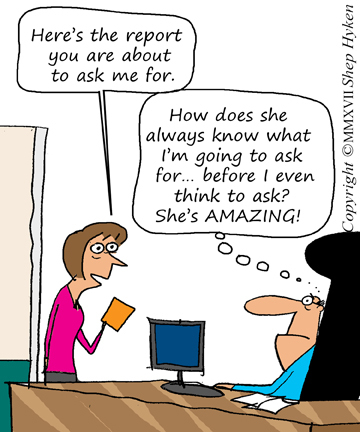 Some of you may be familiar with the 1970’s and 80’s hit TV show M*A*S*H, based on the novel and movie by the same name. The series premiered in 1972 and played for eleven seasons. While, most refer to the show as a sitcom, some view it more as a “dramedy” than a comedy series because of the heavy dramatic setting, which was a medical unit in the Korean War. Sure, there were a lot of laughs, but the message behind the show was very serious. So, what does all of this have to do with customer service?
Some of you may be familiar with the 1970’s and 80’s hit TV show M*A*S*H, based on the novel and movie by the same name. The series premiered in 1972 and played for eleven seasons. While, most refer to the show as a sitcom, some view it more as a “dramedy” than a comedy series because of the heavy dramatic setting, which was a medical unit in the Korean War. Sure, there were a lot of laughs, but the message behind the show was very serious. So, what does all of this have to do with customer service?
One of the characters, Corporal Walter “Radar” O’Reilly, played by Gary Burghoff, set a standard for customer service. He worked for Colonel Potter, who ran the unit. It was always a good laugh when Colonel Potter barked out a request for a file and Radar was walking into his office with the file before the Colonel finished his request. It was as if he could read minds, or as his nickname indicates, as if he had radar.
This reminded me of an interview I had with a potential employee that was applying to be my assistant here at Shepard Presentations. I asked her what her definition of a good assistant would be. She actually didn’t give me the answer I thought I might get. She said, “Radar O’Reilly.” She said, that’s the kind of assistant I want to be – knowing what you want before you even ask for it.
Whether it’s for the job of an assistant to an executive or assisting a customer, one of the attributes of someone who delivers outstanding customers service is the ability to anticipate a customer’s needs – like Radar, knowing what he or she wants before they ask.
It doesn’t take E.S.P., Extra Sensory Perception, which is the ability to read minds. It takes what I call E.A.P., or Extra Awareness Perception, the ability to know more, because you are aware and pay close attention. That’s really all this is; paying close attention to your customers, their behaviors, their habits and more. When you start to study your customers and know them that well, you’ll be able to anticipate or predict, with uncanny accuracy, what they will ask for next – sometimes even before they know they need to ask.
So, as we think about Radar O’Reilly’s uncanny ability to anticipate what Colonel Potter will ask for next time, think about what your customers are going to ask for next. I’ll bet your guess is more accurate than you think. Take the initiative and deliver a standard of customer service that would make Radar proud. The result will be… customer amazement!
Shep Hyken is a customer service expert, keynote speaker and New York Times bestselling business author. For information contact or www.hyken.com. For information on The Customer Focus™ customer service training programs go to www.thecustomerfocus.com. Follow on Twitter: @Hyken
(Copyright © MMXVII, Shep Hyken)
Save
Save
Save
The post Anticipatory Customer Service: The Radar O’Reilly Standard appeared first on Shep Hyken.
February 28, 2017
Amazing Business Radio: Kyle Christensen
 Kyle Christensen Says Don’t Cut That Cord:
Kyle Christensen Says Don’t Cut That Cord:How Technology Will Help You Deliver a Better Customer Service Experience
Rather than attempt to cut the costs of delivering customer service on the phone, how you can use that opportunity to actually increase customer satisfaction and revenue through the use of technology?
Shep Hyken speaks with Kyle Christensen, VP of Marketing at Invoca, about using technology to create a better customer experience.
First Up:
Shep Hyken’s opening comments focus on how it is reasonable for our customers to expect a good experience on the phone. They shouldn’t have to know and repeat their account number. They shouldn’t need to be transferred to someone else. They shouldn’t have to tell their story again and again. As usual, Shep shares examples that we can all relate to that give clarity to his ideas and concepts.
Featured Interview:
Shep begins his interview by asking Kyle Christensen, Senior VP of Marketing at Invoca, “How can you enhance the experience of customers on the phone?”
Christensen responded by saying, that customers have avoided calling and have sought out answers on their own because we have made the phone experience a painful one. The problem is that some companies haven’t invested in the right processes and technology. First, they can make it difficult to even find the customer service phone number –almost hiding it on their websites. Second, they make the customer navigate through a phone tree with (what seems like) at least seven options. Third, if the customer does find the correct option, companies make you sit on hold for (what seems like) 10 minutes before ever talking to someone.
While we are pushing people toward alternative solutions to customer service, we must recognize the power of the live phone conversation with a customer.
Artificial intelligence, is going to unlock an incredible amount of data that has never been available before, particularly as it relates to voice. Through the use of technology, customer service agents will be able to deliver a better customer service experience. As a result, customers won’t need to announce their account number three times during a series of conversations. The system will already know this and additional information about them that the agent can readily access.
The resulting frictionless conversation can deliver a better service experience and the agent can get feedback about their customers’ needs and expectations. This can be a goldmine of information that the agent can then use to deliver a better customer experience and to find opportunities to create more revenue.
Top Takeaways:
74% of people who have a bad phone support experience are likely to choose another business the next time they shop for that product or service. In fact, 70% of them will also complain to their friends and family about that experience.
If they are using their smartphone rather than their desktop computer, people are three times more likely to make a call to the business rather than to fill out a form to contact that business.
AI will help support agents eliminate the common problems with support calls, by providing account information automatically to agents with customer voice recognition.
ABOUT:
Kyle Christensen is the Senior Vice President of Marketing at Invoca, a call intelligence company. Kyle has also served in senior strategic product marketing and management roles at Zuora and at Salesforce.com where he ran enterprise marketing for Data.com and helped launch the Service Cloud line of business.
Shep Hyken is a customer service and experience expert, best-selling author and your host of Amazing Business Radio.
“There is something inherently human in having a conversation with another human.” – Kyle Christensen
This episode of Amazing Business Radio with Shep Hyken answers the following questions… and more:
How will artificial intelligence affect customer service?
What is an intelligent assistant?
What is call intelligence?
How can we improve the digital customer experience?
Will technology replace humans in delivering customer service?
Save
Save
Save
The post Amazing Business Radio: Kyle Christensen appeared first on Shep Hyken.






